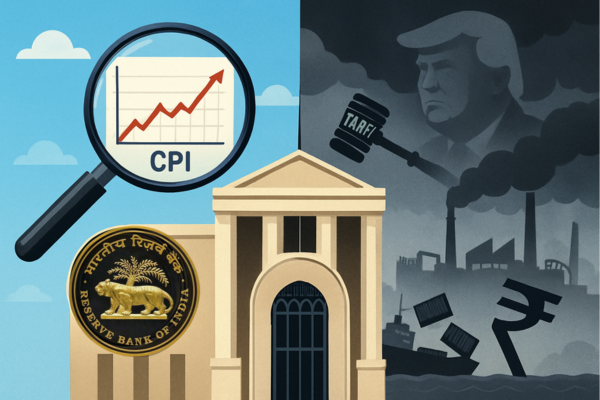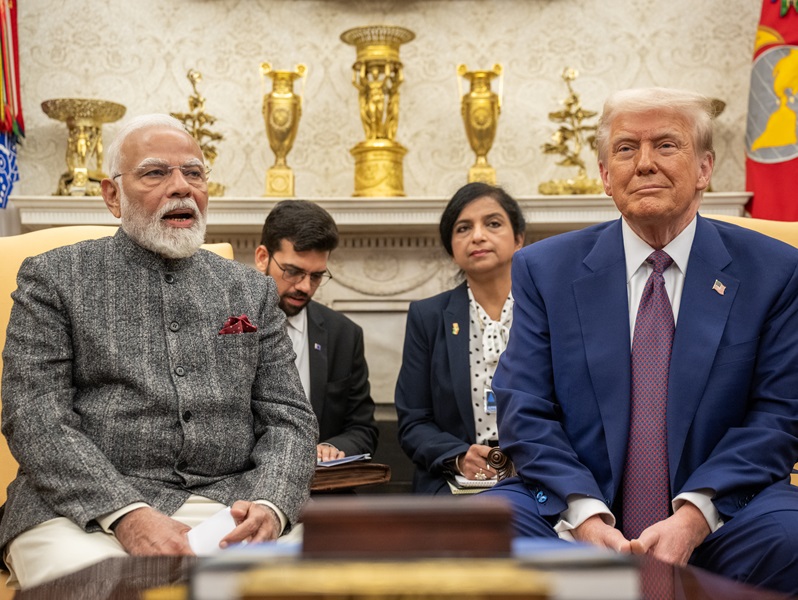.png)
RBI’s Inflation Vigil Misses Trade Storm Clouds
The central bank’s hawkish turn on core inflation ignores looming growth risks from Trump tariffs and slowing domestic demand.


Groupthink is the House View of BasisPoint’s in-house columnists.
August 6, 2025 at 7:39 AM IST
The Reserve Bank of India has surprised no one by holding the repo rate at 5.50%, yet the message behind Wednesday’s monetary policy statement was anything but neutral. Inflation has collapsed to a six-year low of 2.1% on the back of food deflation, but policymakers are signalling that the easing cycle is over.
In shifting the spotlight to core inflation, which has crept up to 4.4%, and projecting headline inflation climbing to nearly 5% a year ahead, the central bank may have effectively closed the door on further cuts for now. It could have benefited from keeping its powder dry and preserving flexibility for more easing, should growth falter.
Whether intended or not, the bar for additional cuts now looks considerably higher.
This hawkish inflexion comes at a delicate moment.
Bond markets had quietly positioned for a rate cut, expecting growth headwinds to strengthen through the year, even as consensus called for the status quo. They are now recalibrating, recognising that the RBI’s bias is tilted toward caution rather than stimulus. Yet this resolve to pre empt a possible rise in inflation may be premature, given the fault lines emerging on the growth front.
The MPC’s growth narrative rests on familiar domestic supports: an above-normal monsoon, rising capacity utilisation, government capital expenditure, and buoyant services. Real GDP growth for 2025 26 is pegged at 6.5%, with evenly balanced risks. But this optimism appears increasingly detached from ground realities. A wave of tariffs from the US, including those targeting Indian exports, threatens to sap external demand. Domestic high-frequency indicators already hint at a loss of momentum in consumption and manufacturing, and the boost from earlier rate cuts has yet to show up in credit growth in any meaningful way.
The oft-cited surge in PMI often masks the real picture of manufacturing.
That disconnect is striking. Since February, the RBI has delivered 100 basis points of rate cuts and infused significant liquidity, a front-loaded easing cycle aimed at cushioning the economy from global shocks. The full impact of this easing is still unfolding. Yet rather than signal patience to assess transmission, the central bank has shifted focus to the risk that these very actions could stoke core inflation later in the year. The concern is not unfounded, but it risks overstating a narrow price measure and downplaying the broader disinflationary impulse still at work in food and fuel prices.
The inflation trajectory outlined in the statement strengthens this impression. Headline CPI is expected to stay around 3% for most of this financial year before rising above 4% in the final quarter and close to 5% in the first quarter of 2026 27. That rise is driven partly by base effects rather than new price pressures.
Core inflation is projected to hover slightly above 4%, a level hardly inconsistent with the trend of the last two years and with the target band for the headline CPI. By anchoring policy on this forward projection rather than the current benign reality, the RBI risks tightening the real rate burden just as growth softens.
Equally notable is what the statement leaves unsaid.
There is little acknowledgement of the likely fallout from US tariffs on Indian exporters or the broader trade uncertainty clouding the growth outlook. For an economy that has leaned on services exports and global supply chains for incremental growth, this silence is conspicuous. The governor’s concluding remarks about “stronger policy frameworks across domains” hint at the need for coordinated responses, but the immediate burden of adjustment is being left to monetary policy alone.
For now, markets will test this stance against incoming data. Softer GDP prints or signs of faltering demand could revive calls for more easing, challenging the central bank’s resolve. Conversely, any upside surprise in core inflation will vindicate the current vigilance. The RBI is walking a narrow ridge between credibility on price stability and the risk of under-delivering on growth support.
The danger is that the central bank mistakes a temporary reprieve in food prices for lasting stability and shuts off easing too soon. If growth undershoots in the coming quarters, it may find itself forced into an awkward U-turn, a move far costlier for credibility than a more open-ended pause today. Right now, the bigger risk is not runaway inflation but being blindsided on growth — and this policy stance leaves little room to manoeuvre if that risk materialises.



